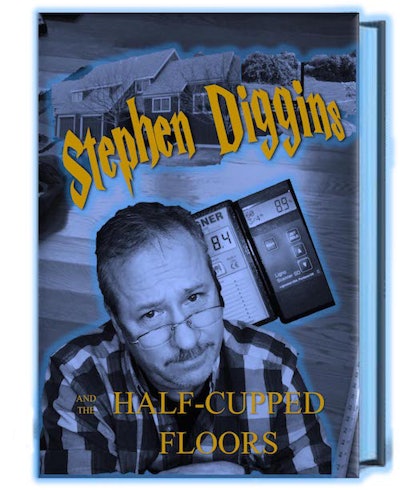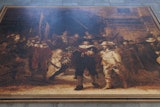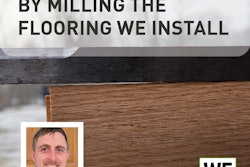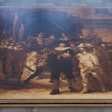
“You know, it’s amazing how many super-villains have advanced degrees. Graduate schools should do a better job at screening those people out.”
—Sheldon Lee Cooper, B.S., M.S., M.A., Ph.D., Caltech theoretical physicist
The comedic assertion above is quite accurate. If you do a little research on super-villains—Dr. Doom, Dr. Evil, Dr. Death, Professor Moriarty, Dr. Hannibal Lector—they all have “advanced degrees.” Well, so do we, the flooring faithful. Not only have we educated ourselves in the field of hard knocks, but we are likely one good urethane spill away from becoming super-villains ourselves! Me? I am not a floor doctor, but I play one in real life.
Our next mystery got so strange and dragged out that I thought we might have to throw it into the cold-case file along with the bed bug hypothesis from Mystery #1: The Spreading Black Spots. But at the last minute, I received the results I was looking for, and the answers to this mystery are in the vault. The photos and information I offer will give you facts and clues as to what went wrong with this hardwood floor system and how the case was cracked. It was a true anomaly.
WFB Readers, you are going to have to reach back in time and use some earth science, physics, chemistry and math to crack this one for sure. Also, some keen analysis by you, our readers, as Hardwood Contractor Site Inspectors (you guessed it: CSI Floor Guys). Here, Wood Floor 101 is a prerequisite, and your experience is a mandatory requirement.
Part 1 of this series gives you the layout and issues, as well as pertinent clues. Part II will have more revealing photos and clues for those who might still be “puzzled,” and Part 3 will be our big reveal. With our advanced-education theme in mind, I bring you our third installment of strange-but-true hardwood flooring stories: Mystery 3:The Tale of The Half-Cupped Floors.
I inspected a series of hardwood floors (kitchen, dining Room, living room, entry landings and bedrooms) in a tri-level condominium unit nestled in a cozy little New England village at the base of sprawling mountains and rolling hills. I had received a call from David & Lisa Dupee of Dupee Hardwood Flooring, North Adams, Mass. They told me they had refinished several floors in the condo unit and had also installed and finished other rooms in the home, including a wide-plank red oak with pegs. The customer complained that after several weeks the floors began to cup. Mild cupping was apparent in the photos I was sent, which was strange because it was winter—not usually the time for mild “seasonal cupping.” At this point, if we can agree we are all on the same page, I expected gapping, not this. Dave sent me photos, which you can see in this blog along with my own and those of the condo owner/occupant.

As much as the photos baffled me, the site inspection was even more bizarre. Most of the floor was red oak 3 ¼-inch select & better throughout the home with a mild brown stain and oil-modified finish. The oldest floor on the main living level (kitchen into dining room, on grade, around 5o years old) looked fine. Photos show the adjacent living room flooring was elevated three steps up. That floor looked fine, too, as well as the new wide-width plank flooring in the kitchen, which was laid in an opposite direction where it ran perpendicular to the existing dining room flooring. The wide-plank was glued and cleat-nailed as well as screwed and pegged (plugged). Most of the first-floor material was perfectly fine, and it was over a crawl space. Only the entry had lifted (buckled) against the stair riser and tore the quarter round off the skirt boards and stair riser. Please note that other than the entry landing, this section of the condo was an open-concept design with vaulted ceilings and was on the right side of the unit when facing the home (also to the right of the three-level stair system). The living space and kitchen were on the right, stairs and bedrooms on the left.

The second half of the condo (the left side) had existing hardwood stairs and a first-floor 3-by-6-foot entry on-grade and a similar landing on the second floor on plywood well above grade. It was all 3 1/4-inch red oak flooring to match existing. New matching flooring had been installed in several bedrooms; all averaged 300 square feet. All of these floors were slightly, but noticeably cupped.
In summary: All the floors to the right of the home were fine. All the floors to the left and on all three levels were cupped. The landing was actually buckled on the ground floor entry (see the photo on the top right of the floor photos above). Now it got even more weird.


The home measured a consistent 30% RH at 73 degrees Fahrenheit throughout. The floors measured 6-8% moisture content, and the measurement of 10 rows was 32.5” and 65” on 20 rows. The floors to the right of the home measured the same, yet they were not cupped at all! The floors to the left measured perfect for the mid-winter climate and yet they were cupped?! How was it that all the flooring in the home was acclimated to the same conditions and regardless of whether they were new or old they performed differently on one side of the home than the other? The living room and kitchen/dining room were over a crawl space, and yet the major concern was the floors two stories above?!
I started at the third floor, confident that some snow or ice damn had melted into the walls and pooled between the ceiling layers and the flooring systems. I had seen that before. Rare, but real. It had happened where a frozen pipe slowly spray-misted an attic space until the water found its level and followed the plastic above the drywall like a swimming pool until it found an electrical socket for an overhead light and then it was show time! ZAP ZAP ZAP! POP! Lights out!
In most cases, second- and third-floor systems are not of too much cause for concern for humidity and moisture migration, and more than likely, flooring issues are the results from full-on water damage. I found none of that. If you will observe the photos of my meter readings, you will see everything appeared normal throughout, or did it?
I leave to you, the readers, many clues for you to begin piecing this mystery together. I choose not to give you much more than to tell you that before I post Part 2, you should be able to look at my readings, measurements, room scenes, writing and site photos to start building your case. Study closely! Examine everything as if you were there. I can assure you all the answers for your hypothesis are here, and I will post more as you pick it apart. Ask any questions you like and I will answer yes or no, and maybe offer a little bit more to keep you rolling. If your questions are accurate and revealing, I will post further photos and information. In Part 2 I will go deeper into one of the oddest and more technical inspections I have ever encountered and why this made our list as the third “Mystery Floor.” Remember that the floor always tells the story, and nothing is always as it appears.
Good luck to all and please post all you like. Share answers and insights. Ask me questions. Start by breaking it down to the base causes for what you see as wrong and then we will crack this case wide open. The game is a floor, my friends!
PS: On November 24, 1971, Dr. Cooper was not yet born, but Cooper was involved in an unsolved mystery involving hundreds of thousands of dollars in stolen money that was never found, at least not completely. Cooper could offer at least two initial components to our flooring puzzle. That would at least get you halfway there, mathematically speaking. The details will unfold before you like a Swiss Army knife if your approach is principled enough. Draft what conclusions you can from the material provided and be cautious not to air out lofty conclusions. Send me questions and if it gets frustrating feel free to vent, I can take it. Please play nice with the other floor guys … we are professionals.
See more wood floor mysteries from Stephen Diggins:
Wood Floor Mystery #1: The Spreading Black Spots
Wood Floor Mystery #2: The Poly That Wouldn't Stick
Wood Floor Mystery #4: How Did This Floor Get Like This?
Wood Floor Mystery #5: The Uniform Gaps
Wood Floor Mystery #6: The Case of the Crawling Finish
Wood Floor Mystery #7: The Case of the ‘Burned’ Floor
Wood Floor Mystery #8: Is This Floor Fungus Among Us?
Wood Floor Mystery #9: A 'Sight' Inspection of a 'Disappearing' Gunstock Wood Floor, Part 1
































